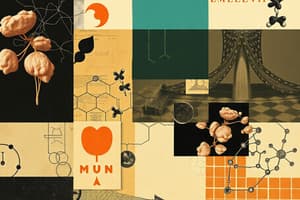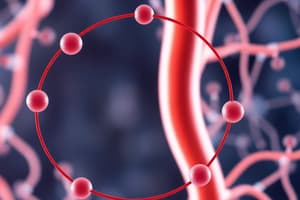Podcast
Questions and Answers
Which process allows pyruvic acid to be converted to lactic acid?
Which process allows pyruvic acid to be converted to lactic acid?
- Amination
- Oxidative decarboxylation
- Decarboxylation of oxaloacetic acid
- Reduction in the absence of O2 (correct)
What is the primary energy production pathway that involves the conversion of acetyl CoA?
What is the primary energy production pathway that involves the conversion of acetyl CoA?
- Beta-oxidation
- Glycolysis
- Oxidative phosphorylation
- TCA cycle (correct)
Where does the TCA cycle predominantly occur within a cell?
Where does the TCA cycle predominantly occur within a cell?
- Inner mitochondrial membrane
- Nucleus
- Mitochondrial matrix (correct)
- Cytosol
Which of the following statements about the TCA cycle is incorrect?
Which of the following statements about the TCA cycle is incorrect?
What enzyme complex is responsible for converting pyruvate into acetyl CoA?
What enzyme complex is responsible for converting pyruvate into acetyl CoA?
What is the total net gain of ATP from the oxidation of one molecule of acetyl CoA in the TCA cycle?
What is the total net gain of ATP from the oxidation of one molecule of acetyl CoA in the TCA cycle?
Which reaction in the TCA cycle generates GTP through substrate-level phosphorylation?
Which reaction in the TCA cycle generates GTP through substrate-level phosphorylation?
What are the main roles of the intermediates produced in the TCA cycle?
What are the main roles of the intermediates produced in the TCA cycle?
What is the impact of anoxia or hypoxia on the TCA cycle?
What is the impact of anoxia or hypoxia on the TCA cycle?
Which coenzymes are primarily responsible for transferring reducing equivalents in the TCA cycle?
Which coenzymes are primarily responsible for transferring reducing equivalents in the TCA cycle?
Flashcards are hidden until you start studying
Study Notes
Pyruvate Metabolism
-
Pyruvate, a key molecule in metabolism, can be formed through various pathways including:
- Glucose oxidation (glycolysis)
- Lactic acid oxidation
- Alanine deamination
- Glucogenic amino acid conversion
- Oxaloacetic acid decarboxylation
-
Pyruvate has multiple fates depending on the cellular environment and metabolic needs:
- Oxidative decarboxylation to acetyl-CoA: This occurs in the presence of oxygen and is a key step in the TCA cycle.
- Reduction to lactic acid: This occurs in the absence of oxygen (anaerobic conditions).
- Amination to alanine: This is a reversible reaction involved in amino acid metabolism.
- Gluconeogenesis: Pyruvate can be converted back to glucose in a process called gluconeogenesis.
- Conversion to malic acid: This is an intermediate step in some metabolic pathways.
- Carboxylation to oxaloacetic acid: This involves the fixation of carbon dioxide and is crucial for TCA cycle activity.
Citric Acid Cycle
- The citric acid cycle (TCA cycle, or Krebs cycle) is the primary energy-producing pathway in the body.
- It occurs in the mitochondria, a specialized organelle within cells.
- The cycle is a series of interconnected reactions that involve oxidation-reduction and other transformations.
- It is the final common pathway for the breakdown (catabolism) of carbohydrates, fats, and proteins.
- Acetyl-CoA derived from glucose, fatty acids, and some amino acids enters the cycle by combining with oxaloacetic acid (OAA) to form citrate.
- Through a series of steps involving dehydrogenations and carbon dioxide (CO2) release, the cycle regenerates OAA, which can then accept another acetyl group from acetyl-CoA.
- All TCA cycle enzymes are found in the mitochondrial matrix except succinate dehydrogenase, which is located in the inner mitochondrial membrane.
- Electrons are transferred to NAD+ and FAD during the cycle.
- These reduced coenzymes (NADH and FADH2) subsequently donate their electrons to the electron transport chain, leading to ATP generation through oxidative phosphorylation.
- One GTP molecule is generated per cycle through substrate-level phosphorylation.
- The entire process is aerobic, requiring oxygen as the final electron acceptor.
- The TCA cycle is crucial for energy production.
Key Enzymes of the TCA Cycle
- Citrate synthase: Catalyzes the initial condensation of acetyl-CoA with OAA to form citrate.
- Isocitrate dehydrogenase (ICD): Catalyzes the oxidative decarboxylation of isocitrate to α-ketoglutarate, generating NADH.
- α-ketoglutarate dehydrogenase: Catalyzes the oxidative decarboxylation of α-ketoglutarate to succinyl-CoA, generating NADH and CO2.
Biomedical Importance of the TCA Cycle
- It is the final common pathway for the catabolism of carbohydrates, proteins, and fats, with acetyl-CoA serving as the central molecule.
- It plays a major role in energy production by oxidizing acetyl-CoA to CO2 and H2O, yielding ATP.
- It provides intermediates for anabolic pathways such as heme synthesis, non-essential amino acid synthesis, fatty acid synthesis, cholesterol synthesis, and steroid synthesis.
Energy Production in the TCA Cycle
- The oxidation of one molecule of acetyl-CoA generates 12 ATP molecules.
- This includes 9 ATP from NADH oxidation, 2 ATP from FADH2 oxidation, and 1 ATP from GTP production.
Electron Transport Chain and Oxidative Phosphorylation
- The electron transport chain (ETC) is the final pathway for electron transfer in aerobic cells, transferring electrons from various substrates to oxygen.
- It is located in the mitochondrial inner membrane and consists of a series of organized redox enzymes.
- The ETC is crucial for energy production as it utilizes energy released from electron transfer to pump protons across the inner mitochondrial membrane.
- This proton gradient creates an electrochemical potential that drives ATP synthesis.
Components of the Electron Transport Chain
- Complex I (NADH-CoQ reductase): Transfers electrons from NADH to CoQ, pumping protons across the membrane.
- Complex II (Succinate-CoQ reductase): Transfers electrons from succinate to CoQ via FADH2.
- Complex III (CoQ-Cyt.C reductase): Transfers electrons from CoQ to cytochrome c, also pumping protons.
- Complex IV (Cyt.C oxidase): Transfers electrons from cytochrome c to oxygen, generating water and pumping protons.
ATP Synthesis in Oxidative Phosphorylation
- Energy from electron transport is used to pump protons across the inner mitochondrial membrane, creating an electrochemical gradient.
- Protons flow back into the matrix through ATP synthase, driving the phosphorylation of ADP to ATP.
- ATP is then transported from the matrix to the cytosol in exchange for ADP.
Clinical Correlations
- Cyanide poisoning: Cyanide binds to cytochrome aa3, blocking electron transport and ATP production, leading to rapid death.
- Acute myocardial infarction: Blockage of coronary arteries can lead to oxygen deprivation in heart muscle, inhibiting electron transport and ATP production.
- This results in energy depletion and damage to heart muscle cells, potentially causing heart failure.
Studying That Suits You
Use AI to generate personalized quizzes and flashcards to suit your learning preferences.



